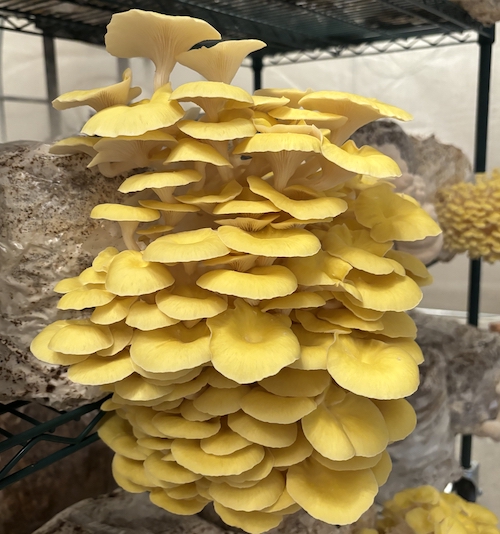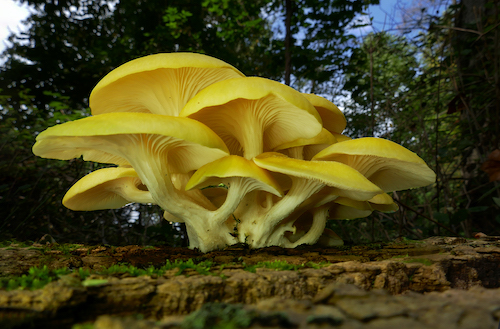Golden Oyster
Pleurotus citrinopileatus
Introduction:
The Golden Oyster Mushroom, scientifically known as Pleurotus citrinopileatus, is an eye-catching edible fungus renowned for its vibrant yellow cap and delicate flavor. A member of the Pleurotus genus, this mushroom is popular not only for its culinary appeal but also for its medicinal properties and suitability for home and commercial cultivation. This article explores the Golden Oyster Mushroom's biology, ecology, and cultivation techniques.

Biology:
Taxonomy:
Pleurotus citrinopileatus derives its name from the Latin "citrinus" (meaning lemon-colored) and "pileatus" (meaning capped), reflecting the distinct lemon-yellow cap color of this species. The Golden Oyster Mushroom is closely related to other oyster mushrooms within the Pleurotus genus and shares many biological and morphological characteristics.
Morphology:
Golden Oyster Mushrooms are characterized by their bright yellow, fan-shaped caps, which range from 2 to 6 centimeters in diameter. The caps are often clustered and overlapping, forming a bouquet-like structure. Beneath the cap, white to cream-colored gills run down the short, often centrally attached stem. Unlike other oyster mushrooms, Golden Oysters have a more delicate structure, which makes them highly perishable and sensitive to handling.
Ecology:

Habitat:
Golden Oyster Mushrooms are saprotrophic, meaning they obtain nutrients by decomposing organic matter. They are commonly found on dead or decaying hardwoods such as elm, oak, and poplar. This species plays an essential ecological role by breaking down lignin and cellulose in wood, contributing to nutrient recycling within forest ecosystems.
Distribution:
Native to subtropical and temperate regions of East Asia, particularly in Japan, China, and parts of Russia, the Golden Oyster Mushroom is well-suited to warm climates. It has also become popular for cultivation in various other regions due to its adaptability and rapid growth.
Cultivation:
Golden Oyster Mushrooms are a popular choice for cultivation due to their unique color, rapid growth rate, and adaptability to different substrates. They are, however, more sensitive to environmental conditions than other oyster mushroom varieties.
Substrate:
Golden Oyster Mushrooms can be cultivated on a variety of substrates, including straw, sawdust, hardwood chips, or a blend of agricultural by-products. They thrive on substrates that are high in lignin and cellulose, making hardwood-based substrates particularly effective.
Cultivation Process:
- Substrate Preparation: The substrate must be pasteurized or sterilized to remove contaminants.
- Inoculation: Mushroom spawn is mixed into the substrate, allowing the mycelium to colonize it over time.
- Incubation: During the incubation phase, the substrate should be kept in a warm, dark environment for optimal mycelium growth.
- Fruiting Conditions: Once fully colonized, the substrate is transferred to a fruiting environment with increased humidity, moderate light, and fresh air exchange. A temperature range of 18–24°C (64–75°F) is ideal for fruiting.
- Harvesting: Golden Oyster Mushrooms should be harvested when the caps are fully developed but before they begin to fade in color or droop. Due to their delicate structure, they should be handled carefully.
Culinary Uses:
Golden Oyster Mushrooms are prized for their mild, nutty flavor and slight citrusy undertone. Popular culinary uses include:
- Sautéed or Stir-Fried: Golden Oysters cook quickly and are often sautéed in butter or oil with herbs for a simple yet flavorful side dish.
- Soups and Stews: These mushrooms add depth to soups and stews without overpowering other flavors, making them a versatile addition to broths and light sauces.
- Pasta and Rice Dishes: Golden Oyster Mushrooms’ subtle flavor complements pasta and rice dishes, adding both color and texture.
- Topping for Salads or Pizzas: Lightly cooked or fresh, Golden Oysters are often used as toppings due to their vibrant color and delicate flavor profile.
Health Benefits:
Beyond their culinary uses, Oyster Mushrooms are valued for their potential health benefits. They are a good source of protein, fiber, and essential nutrients. Some studies suggest that they may possess antioxidant and immunomodulatory properties.
Conclusion:
The Golden Oyster Mushroom, Pleurotus citrinopileatus, is a visually stunning and nutritionally valuable mushroom that has captured the interest of culinary enthusiasts and cultivators alike. Its ease of cultivation, coupled with its unique color and delicate taste, makes it an excellent choice for both amateur and commercial growers. As research and cultivation techniques continue to advance, the Golden Oyster Mushroom remains a fascinating subject for mycological and agricultural exploration.